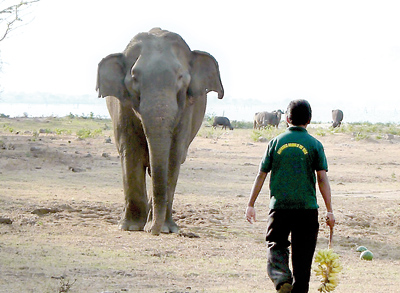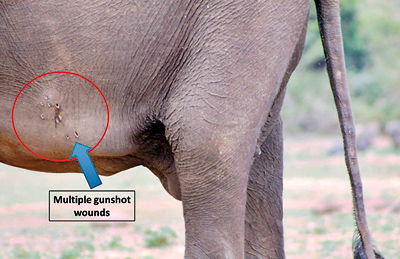Finding Rambo
I kept daily contact with the Uda Walawe National Park, but with no news of Rambo, hope seemed to be receding that he was alive. Deep down I was not convinced, and decided to take a quick drive to the park to do some intense reconnaissance along the western side of the park, abutting the reservoir, which was possibly the area that the sick Rambo might have gone to. I felt that I should be able to even perhaps pick up the smell of a decaying carcass, if he had died in the area.

Dr. Vijitha approaching Rambo with a bunch of bananas
Setting off very early, I reached the park by 8 a.m. I picked up the four wheel drive and my regular driver and tracker, and proceeded to the park. Just as I passed the barrier at the further end of the bund, along the spillway before the Wildlife Society Bungalow, I spotted what looked like a large boulder in the water far away. Unfortunately I had forgotten my binoculars and had to resort to my 400 mm zoom lens to identify it as an elephant.
Only its upper torso was exposed, and it was not moving. Something told me it could be Rambo, but the tracker and driver were sceptical saying that it was ‘just another elephant’. I spent about three hours driving around without finding any sign of Rambo.
Returning around 11.30 a.m., the elephant was still in the same place. My gut feel was that this was Rambo. Injured elephants usually spend a lot of time near the water since they are unable to move around that easily. I called Dr. Vijitha Perera, the veterinary surgeon at Uda Walawe, and he had also just received news of this elephant. He had sent a crew to the park, to get closer to make a positive identification.
Waiting at the Elephant Transit Home (ETH) for Dr.Vijitha, I watched the orphaned elephants being fed. He soon received a call saying that his staff had confirmed that it was definitely Rambo. Both Dr. Vijitha and I were overjoyed. I urged him to immediately go and check Rambo’s condition, but he suggested we wait until evening, when it was cooler, by which time he felt that Rambo would come out of the water.
Around 4 p.m., I went to the spillway to wait for Dr.Vijitha. As he had predicted Rambo slowly began to move towards the shore. He was walking very slowly, in a laboured manner, and gradually came onto land and walked towards the shade of the trees. He was still a good 50 metres away and although I couldn’t really assess his condition, I could see the protrusion at the base of his belly. He seemed very lethargic. By around 5, Dr. Vijitha arrived with his assistants. He had brought along a large stock of fruits, including water melon and banana, into some of which he had introduced antibiotic medicines.

We crept through the first electric fence and then through the second, when Rambo spotted us. Dr. Vijitha started quietly calling to him by name, and soothingly ‘talking to him’. He immediately responded by flaring out his ears and advanced slowly towards Dr. Vijitha.
Quite contrary to what I had imagined, Dr. Vijitha warned that Rambo could be aggressive, and to be alert and ready to run, in case he decided to charge us. However, in his current weak condition he seemed to be quite placid, and in some ways, even happy to see us.
Dr.Vijitha and the staff got quite close to Rambo and rolled the fruit towards him He began eating with some reluctance and meanwhile Dr.Vijitha went around him making a careful inspection of his condition, while keeping a wary eye on him.
He reckoned that Rambo seemed to be responding to treatment, but the problem was that he was not getting enough nutrition. The protrusion in the belly was possibly the collection of fluid either due to an infection or lack of exercise.
Dr. Vijitha also noted some gunshot wounds on Rambo’s left side. Closer inspection revealed multiple pellet holes in a circular pattern which seems to indicate that he had been shot at close range with an old fashioned pellet gun. Thankfully this wound was not festering and with treatment should respond well. The close proximity of the shot indicates that in all probability due to his familiarity with people, Rambo may have wandered close to some villagers, who, not knowing his benign nature would have shot him at close range.
Up close, I was surprised to see how old and emaciated he looked. Dr. Vijitha seemed confident that he may recover well enough, but the long-term issue was that Rambo has got completely acclimatised to being fed now, and it would be very difficult to rehabilitate and get him back to the jungle.
It was indeed sad to see this once majestic elephant, now stooped, prematurely old and gaunt, primarily due to over dependence on the food given by people.
Another sad case of foolish human interaction with a wild animal, for people’s personal satisfaction and entertainment, which eventually is seriously detrimental to the animal and wildlife.
comments powered by Disqus

